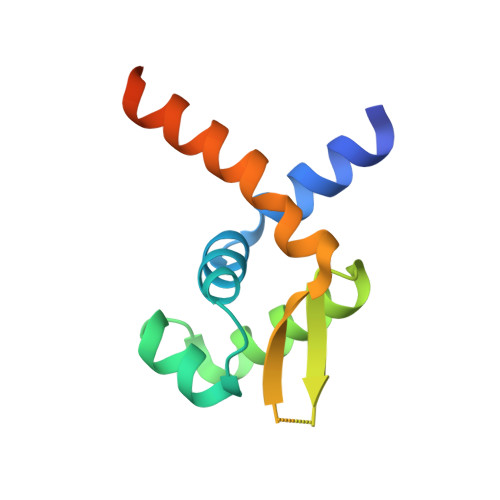Two distinct mechanisms of transcriptional regulation by the redox sensor YodB
Lee, S.J., Lee, I.G., Lee, K.Y., Kim, D.G., Eun, H.J., Yoon, H.J., Chae, S., Song, S.H., Kang, S.O., Seo, M.D., Kim, H.S., Park, S.J., Lee, B.J.(2016) Proc Natl Acad Sci U S A 113: E5202-E5211
- PubMed: 27531959
- DOI: https://doi.org/10.1073/pnas.1604427113
- Primary Citation of Related Structures:
5HS7, 5HS8, 5HS9 - PubMed Abstract:
For bacteria, cysteine thiol groups in proteins are commonly used as thiol-based switches for redox sensing to activate specific detoxification pathways and restore the redox balance. Among the known thiol-based regulatory systems, the MarR/DUF24 family regulators have been reported to sense and respond to reactive electrophilic species, including diamide, quinones, and aldehydes, with high specificity. Here, we report that the prototypical regulator YodB of the MarR/DUF24 family from Bacillus subtilis uses two distinct pathways to regulate transcription in response to two reactive electrophilic species (diamide or methyl-p-benzoquinone), as revealed by X-ray crystallography, NMR spectroscopy, and biochemical experiments. Diamide induces structural changes in the YodB dimer by promoting the formation of disulfide bonds, whereas methyl-p-benzoquinone allows the YodB dimer to be dissociated from DNA, with little effect on the YodB dimer. The results indicate that B. subtilis may discriminate toxic quinones, such as methyl-p-benzoquinone, from diamide to efficiently manage multiple oxidative signals. These results also provide evidence that different thiol-reactive compounds induce dissimilar conformational changes in the regulator to trigger the separate regulation of target DNA. This specific control of YodB is dependent upon the type of thiol-reactive compound present, is linked to its direct transcriptional activity, and is important for the survival of B. subtilis This study of B. subtilis YodB also provides a structural basis for the relationship that exists between the ligand-induced conformational changes adopted by the protein and its functional switch.
Organizational Affiliation:
The Research Institute of Pharmaceutical Sciences, College of Pharmacy, Seoul National University, Gwanak-gu, Seoul 151-742, Republic of Korea;














